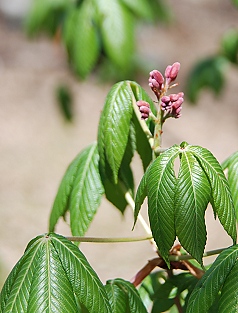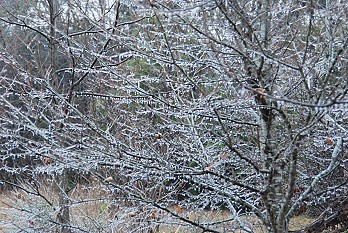Mar 04
Posted: under Land, Plantlife, Weather, Wildlife.
Tags: beauty, native plants, photography, Weather, wildlife management March 4th, 2009
Even in a year this dry, some of the native plants (and a few non-natives) do their best to keep alive and growing. One of the natives we’ve nurtured for years in the yard is the scarlet buckeye, an understory tree that hates sun and drought–but thrives in shady canyons near permanent water. Our version […] [...more]
Even in a year this dry, some of the native plants (and a few non-natives) do their best to keep alive and growing.
One of the natives we’ve nurtured for years in the yard is the scarlet buckeye, an understory tree that hates sun and drought–but thrives in shady canyons near permanent water. Our version of that is the shade of a big old ash and regular watering. I’d like to move its progeny into the creek woods, but right now they’re far too dry (and too far away to water.) It’s just showing its flower buds now; they’ll be open in a few days.

Read the rest of this entry »

Jan 05
Posted: under Weather.
Tags: ice storm, photography, Weather January 5th, 2009
…NOT give us an ice storm. An ice storm after drought is particularly tough on trees weakened by drought. What we’re having is a mix of rain and freezing rain, with temps at ground level just below freezing. Already the junipers are drooping, limbs weighed down by the ice. Here’s a picture of some backyard […] [...more]
…NOT give us an ice storm. An ice storm after drought is particularly tough on trees weakened by drought.
What we’re having is a mix of rain and freezing rain, with temps at ground level just below freezing. Already the junipers are drooping, limbs weighed down by the ice. Here’s a picture of some backyard trees.

Ice storm
Read the rest of this entry »

Dec 12
Posted: under Sky, Weather.
Tags: beauty, Weather December 12th, 2008
In winter, the full moon (or nearly full–let’s not quibble) on a clear cold night makes the whole world silver. And when it sets–that gold coin slipping down into a blue almost the same as the shadowed bottom of a thundercloud, with a band of softest rose above it–it’s worth staring at for the entire […] [...more]
In winter, the full moon (or nearly full–let’s not quibble) on a clear cold night makes the whole world silver. And when it sets–that gold coin slipping down into a blue almost the same as the shadowed bottom of a thundercloud, with a band of softest rose above it–it’s worth staring at for the entire display. Right now it’s visible out my window–half down into the trees across the field–and I’ve been watching for almost an hour as it went from silver to the palest gold, the color deepening moment by moent to the warm golden yellow it is now, the shadow-blue slowly thinning–now with a lavender band that a moment ago was still blue, and the rose above shading to paler and paler rose until it shifts into the pale blue of the dawn sky.
A last sliver of gold now…watching and trying to type as it vanishes, the planet whirling towards dawn…and there…it’s gone.
The horses are munching morning hay. The first birds haven’t shown up yet. Now the blue band is lavender all the way to the horizon, and rapidly turning pinkish. Soon the sun will fire the tops of the red oaks.
Reasons to get up early.

Dec 11
Posted: under Weather.
Tags: freeze December 11th, 2008
Ice on the lily pond this morning–very clear, very cold last night. The birds all look bigger, as they’re all fluffed out. One of the white-wings tried armpitting a blue jay while feeding on the ground, and the blue jay took offense. Come on, dove: look at the relative beak size. And there were three […] [...more]
Ice on the lily pond this morning–very clear, very cold last night. The birds all look bigger, as they’re all fluffed out. One of the white-wings tried armpitting a blue jay while feeding on the ground, and the blue jay took offense. Come on, dove: look at the relative beak size. And there were three jays…you’re outnumbered.
Red oak leaves against the cold blue sky–gorgeous.
Self in multiple layers against the cold and wind–not so gorgeous. Horses and the cat grow nice dense winter coats (as do the wild critters) but humans aren’t so lucky. (Though the shedding problem if we did–ugh!)

Dec 10
Posted: under Weather.
Tags: Weather December 10th, 2008
Yesterday morning was warm (70s) with a damp, strong southerly wind. Then a brief period of relative calm, still warm. Then the norther–strong north wind (dryer at first) with “possible rain”. Ha. This is Texas. What we got was thunder, rain, hail, sleet, and snow…and sleet and snow mixed. Today? Cold (below freezing), nearly clear […] [...more]
Yesterday morning was warm (70s) with a damp, strong southerly wind.
Then a brief period of relative calm, still warm.
Then the norther–strong north wind (dryer at first) with “possible rain”. Ha. This is Texas. What we got was thunder, rain, hail, sleet, and snow…and sleet and snow mixed.
Today? Cold (below freezing), nearly clear skies, and strong north wind.

Dec 08
Posted: under Water, Weather.
Tags: drought December 8th, 2008
Our area is at least sixteen inches below average annual rainfall this year–that’s means we’ve had less than half the average. The “at least” is because what rain we’ve had has been spotty–one place might get four inches and another none, from the same weather system. In addition to the lack of rainfall, aquifers and […] [...more]
Our area is at least sixteen inches below average annual rainfall this year–that’s means we’ve had less than half the average. The “at least” is because what rain we’ve had has been spotty–one place might get four inches and another none, from the same weather system.
In addition to the lack of rainfall, aquifers and reservoirs both are sinking. One of our town’s four wells isn’t producing at all, and the other three are pumping less than normal. A development-friendly county government has supported rapid growth, both residential and commercial, with the predictable (but not to them) growth in demand for water…hence many new wells, all tapping the same resource…shallow wells tapping the groundwater that used to supply springs and small creeks in dry years, and deep wells (to Trinity Sands, the main deep aquifer) for “permanent” water. Creeks and springs–even one river–have dried up completely in the past year.
From the land manager’s perspective, rainfall is THE water resource in this part of the world. We have two “rain barns” to collect and store rainwater (and are working on another–trusses for its roof are finished and being painted.) This stored water provides permanent (we hope) water for wildlife at three different sites and each site is optimized for a different use.
Wildlife (and re-introduction of native plants to improve natural food supplies and habitat) must have reliable water. This year, it was all we could do to keep the wildlife supply going. We lost approximately 90% (maybe more–we’ll know next spring) of the past two years’ worth of plantings because we could not provide enough water…what we could provide, we allocated to a few of the plantings easiest to reach with a bucket.
But if it doesn’t rain…there’s nothing to collect. I designed the collection area/storage capacity for a little below the previously recorded worst-case–ten inches a year–but that’s where we are right now.
The bright spot in this is the response of the original (and re-introduced) natives that didn’t croak. The deep-rooted tallgrass dominants stayed green: big bluestem, switchgrass, Indiangrass, little bluestem, even eastern gama (the water lover of the bunch) are all fine (so far.) Up on the dryest area (a rocky knoll with very thin soil, if any) some didn’t make it–even agarita, which normally grows out of rock anyway–but some did. We have more two-leaved senna and partridge pea than before. We have a new odd milkweed (the experts are still arguing over it.) The Mirabilis alba and Pitcher Sage have both spread this year, and the Maximilian Sunflower, though less than half the height in an average year, has continued to spread sideways in its clumps.



